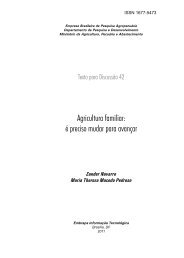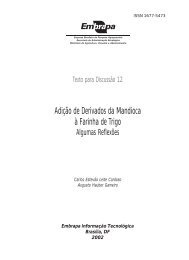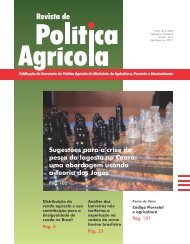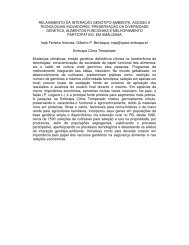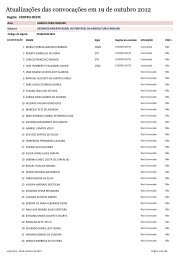Ministry of Agriculture, Livestock and Food Supply - Embrapa
Ministry of Agriculture, Livestock and Food Supply - Embrapa
Ministry of Agriculture, Livestock and Food Supply - Embrapa
Create successful ePaper yourself
Turn your PDF publications into a flip-book with our unique Google optimized e-Paper software.
• The growing energy dem<strong>and</strong> <strong>and</strong> the recent trend toward the use <strong>of</strong> energy<br />
biomass will be driven by the developing countries, whose new energy dem<strong>and</strong><br />
will attain 5 TW over the next 40 years. It is unimaginable that fossil sources could<br />
meet such dem<strong>and</strong> because <strong>of</strong> the huge environmental impact, growing financial<br />
costs <strong>and</strong> depletion <strong>of</strong> petroleum reserves.<br />
• The environmental costs will gradually be incorporated into the price <strong>of</strong><br />
fossil fuels as a result <strong>of</strong> the punitive taxes (pollution tax) imposed, which will<br />
progressively make them more expensive; this will further worsened by the natural<br />
prices increases caused by petroleum reserves depletion.<br />
• Public <strong>and</strong> private investments in the development <strong>of</strong> innovations that<br />
ensure the viability <strong>of</strong> renewable <strong>and</strong> sustainable sources <strong>of</strong> energy (with emphasis<br />
on the use <strong>of</strong> biomass) are growing exponentially.<br />
• There is also a growing number <strong>of</strong> international investors interested in<br />
long-term contract for the supply <strong>of</strong> bi<strong>of</strong>uels, especially alcohol <strong>and</strong>, to a lesser<br />
extent, biodiesel <strong>and</strong> other biomass products.<br />
• Energy will become an important component <strong>of</strong> agricultural <strong>and</strong> agroindustrial<br />
production costs, making cogeneration progressively attractive.<br />
Table 4 lists the cost <strong>of</strong> electric power generation from different sources, by<br />
country in Western Europe, <strong>and</strong> shows that bioenergy is beginning to compete<br />
with coal <strong>and</strong> gas.<br />
Table 4. Electric power generation costs in Europe for diverse primary sources<br />
(Eurocents/kWh – 1990 prices).<br />
Country<br />
Austria<br />
Belgium<br />
Denmark<br />
Engl<strong>and</strong><br />
Finl<strong>and</strong><br />
France<br />
Germany<br />
Greece<br />
Irel<strong>and</strong><br />
Italy<br />
Netherl<strong>and</strong>s<br />
Portugal<br />
Spain<br />
Sweden<br />
Coal<br />
3.6<br />
3.2<br />
3.6<br />
3.2<br />
3.2<br />
3.2<br />
3.5<br />
3.2<br />
3.2<br />
3.6<br />
3.2<br />
3.6<br />
3.6<br />
3.2<br />
Combine<br />
cycle gas<br />
3.4<br />
2.8<br />
2.9<br />
2.6<br />
3.2<br />
3.5<br />
3.5<br />
3.2<br />
3.4<br />
2.6<br />
3.4<br />
3.5<br />
3.3<br />
2.6<br />
Bioenergy<br />
55<br />
3.6<br />
3.7<br />
3.9<br />
3.9<br />
4.0<br />
4.3<br />
4.0<br />
4.5<br />
4.0<br />
4.0<br />
4.3<br />
4.3<br />
3.4<br />
3.8<br />
Source: AEN/NEA – IEA – Projected costs <strong>of</strong> generating electricity.<br />
Wind<br />
7.2<br />
7.2<br />
6.7<br />
7.2<br />
7.2<br />
6.8<br />
7.2<br />
7.2<br />
7.2<br />
7.2<br />
7.2<br />
7.1<br />
7.2<br />
7.2<br />
Solar<br />
64.0<br />
64.0<br />
85.3<br />
85.3<br />
51.2<br />
64.0<br />
51.2<br />
85.3<br />
51.2<br />
64.0<br />
51.2<br />
51.2<br />
85.3<br />
64.0<br />
Nuclear<br />
5.9<br />
4.0<br />
5.9<br />
3.8<br />
3.4<br />
5.1l<br />
4.6<br />
4.7<br />
5.0<br />
5.1<br />
5.9<br />
4.7<br />
4.7<br />
4.3




